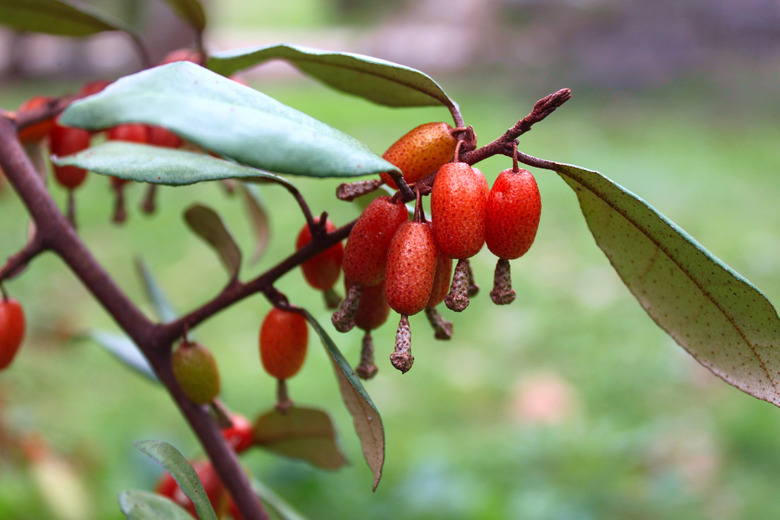How To Plant Elaeagnus
Prized for their silvery foliage and dense growth habit, elaeagnus shrubs (Elaeagnus spp.) work equally well as hedges and low-maintenance specimen shrubs. They recover quickly after planting, adapting well to most conditions and producing masses of fragrant blossoms in summer. However, for all their good traits, elaeagnus shrubs aren't without drawbacks because they may self-seed and become invasive in warmer climates. Check with your local cooperative extension service before planting an elaeagnus shrub to avoid having a potential invasive problem down the road.
Climate Considerations
Climate Considerations
The hardiness and cold tolerance of elaeagnus shrubs vary between species and cultivars. Thorny elaeagnus (Elaeagnus pungens), also called silverthorn, and variegated elaeagnus (Elaeagnus pungens 'Maculata') are perennials in U.S. Department of Agriculture plant hardiness zones 7 through 9, while the Russian olive shrub (Elaeagnus angustifolia, zones 2-7), autumn olive (Elaeagnus umbellata, zones 4-9) and silverbush elaeagnus (Elaeagnus 'Quicksilver,' zones 4-8) are more cold tolerant.
Site Selection and Preparation
Site Selection and Preparation
Most elaeagnus shrubs perform best in full sun, although evergreen species benefit from light afternoon shade in warmer climates. They're not picky about their soil, but it needs to be fast draining with moderate fertility. Whether you're planting a Russian olive hedge or another variety, avoid areas where water pools after rain, as well as heavily shaded sites.
Weed and till the planting site to improve the soil texture and drainage, removing any stones or other bits of debris from the site. Do not amend the soil before planting because it discourages the shrub's roots from extending beyond the amended area and can cause drainage problems.
Elaeagnus Timing and Spacing
Elaeagnus Timing and Spacing
Elaeagnus shrubs should be planted in autumn where hard frost and snow are rare, and in spring several weeks after the last frost in colder climates. Dig a planting hole that is two to three times wider than the shrub's rootball and of the same depth. If drainage is an issue, dig a hole that is 2 inches shallower than the rootball.
Spacing depends on the shrub's mature spread, which varies between elaeagnus species. Space thorny elaeagnus 12 feet apart, and autumn olive 10 to 15 feet apart. When growing elaeagnus as a hedge, dig a planting trench and space them 4 to 6 feet apart.
Planting Tips
Planting Tips
Elaeagnus shrubs may develop compacted or girdled roots during their time in the nursery, so they may need a little extra attention at planting time. Remove the shrub from its pot or burlap and inspect the roots. If they're coiled around the outside of the rootball, make a 1- to 2-inch-deep slice from top to bottom in three or four different places around the exterior.
Settle the rootball in the center of the hole, and have a helper hold it upright to keep the trunk straight. Backfill around the rootball with unamended soil until it's completely covered. Water to a 12-inch depth after planting to settle the soil and hydrate the roots.
Watering and Aftercare
Watering and Aftercare
Although highly drought tolerant once established, elaeagnus shrubs need plenty of water during their first season to promote a deep, productive root system. After planting, build a 3-inch-tall soil ring around the outer edge of the shrub's rootball to direct water toward the roots. Fill the watering ring with 2 to 3 inches of mulch to conserve soil moisture.
Provide roughly 1 inch of water weekly during the first summer, running water until the soil is wet in the top 12 inches. Cool weather decreases the need for water, so check the soil moisture regularly. Only water the plant if it feels dry 2 to 3 inches below the surface.
A Word of Warning
A Word of Warning
The hardy, adaptable nature of elaeagnus shrubs makes them a low-maintenance addition to any landscape. However, it also makes them prone to becoming invasive. The state of Florida classifies thorny elaeagnus as an exotic plant pest due to its ability to escape cultivation and colonize wild areas, where it displaces native plants. Planting sterile cultivars such as silverbush elaeagnus (Elaeagnus 'Quicksilver) will help limit their spread, but it's still best not to plant elaeagnus shrubs in areas where they're known to be problematic.
